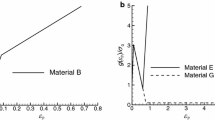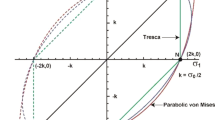Summary
In this work the asymptotic near-tip stress and velocity fields of a crack propagating steadily and quasi-statically along a ductile interface are presented for plane stress cases. The elastic-plastic materials are characterized by the J2-flow theory with linear plastic hardening. The solutions are assumed to be of variable-separable form with a power singularity in the radial distance to the crack tip. It is found that two distinct solutions exist with slightly different singularity strengths and very different mixities on the interface ahead of the crack tip. One of the solutions corresponds to a tensile-like mode and the other corresponds to a shear-like mode. An interface will change the near-tip fild of the tensile solution obviously, whereas the shear-like solution maintains its original structure as in homogeneous materials. In cases the elastic bimaterial parameter differs from zero, the two solutions can coalesce at some high strain-hardening. An interface between two high strain-hardening materials only slightly affects the stress and velocity distribution around the tip, whereas the singularity strength deviates from the homogeneous solutions. The strength of the singularity is predominantly determined by the smaller strain-hardening material. Poisson's ratio affects variation of the singularity as a function of strain-hardening slightly if the coalescing point of the variable-separable solution is not approached. Only for the very distinct elastic moduli the near-tip field approaches the rigid interface solution.
Similar content being viewed by others
References
Hutchinson, J. W., Suo, Z.: Mixed mode cracking in layered materials. Adv. App. Mech.29, 63–191 (1991).
Shih, C. F.: Cracks on bimaterial interfaces: elasticity and plasticity aspects. Mat. Science Eng.A 143, 77–90 (1991).
Williams, M. L.: The stresses around a fault or crack in dissimilar media. Bull. Seismology Soc. Am.49, 199–204 (1959).
Liechti, K. M.: Moire of crack-opening interferometry in adhesive fracture mechanics. Exp. Mech.25, 255–261 (1985).
Amazigo, J. C., Hutchinson, J. W.: Crack tip fields in steady crack-growth with linear strain-hardening. J. Mech. Physics Solids25, 81–97 (1977).
Rice, J. R., Drugan, W. J., Sham, T. L.: Elastic-plastic analysis of growing cracks. Fracture Mechanics, ASTM STP 700, 189–219 (1980).
Ponte Castañeda, P.: Asymptotic fields in steady crack growth with linear strain hardening. J. Mech. Physics Solids35, 227–268 (1987).
Erdogan, F.: Stress distribution in a nonhomogeneous elastic plane with cracks. ASME J. Appl. Mech.30, 232–236 (1963).
Aravas, N., Sharma, S. M.: An elastoplastic analysis of the interface crack with contact zones. J. Mech. Physics Solids39, 311–344 (1991).
Comninou, M.: The interface crack. ASME J. App. Mech.44, 631–636 (1977).
Bose, K., Ponte Castañeda, P.: Stable crack growth under mixed mode conditions. J. Mech. Physics Solids40, 1053–1103 (1992).
Ponte Castañeda, P., Mataga, P. A.: Stable crack growth along a brittle/ductile interface — I. Near-tip fields. Int. J. Solids Struct.27, 105–133 (1991).
Drugan, W. J.: Near-tip fields for quasi-static crack growth along a ductile-brittle interface. ASME J. Appl. Mech.58, 111–119 (1991).
Yuan, H., Schwalbe, K.-H.: An asymptotic analysis of static and dynamic crack extension along a ductile bimaterial interface. — Anti-plane case. Fracture Mechanics, ASTM STP 1189, 208–226 (1991).
Shih, C. F.: Small-scale yielding analysis of mixed mode plane-strain crack problems. Fract. Analysis, ASTM STP 560, 187–210 (1974).
Sharma, S. M., Aravas, N.: On the development of variable-separable asymptotic elastoplastic solutions for interface cracks. Int. J. Solids Struct.39, 1043–1072 (1993).
Drugan, W. J., Shen, Y.: Restrictions on quasi-statically moving surfaces of strong discontinuity in elastic-plastic solids. J. Mech. Physics Solids35, 771–787 (1987).
Deuflhard, P., Bader, G.: Multiple shooting techniques revised. Technical Report 163, University of Heidelberg, SFR 123, 1982.
Author information
Authors and Affiliations
Rights and permissions
About this article
Cite this article
Yuan, H. Plane stress near-tip field analysis of steady-state crack growth along a linear-hardening elastic-plastic interface. Acta Mechanica 109, 207–226 (1995). https://doi.org/10.1007/BF01176823
Received:
Issue Date:
DOI: https://doi.org/10.1007/BF01176823




